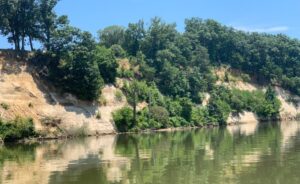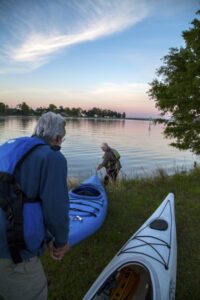
Virginia Indians knew the Northern Neck peninsula by its villages and bodies of water. The current names of many of those waterways and settlements trace their origins to the Virginia Algonquian language. Nestled between the Potomac and Rappahannock Rivers, the “Northern Neck Proprietary” was a gift to Lord Fairfax from the English King Charles II and the region’s navigable creeks and rivers presented opportunities for English colonization in the 17th century. The Northern Neck is the birthplace of two brothers to sign the Declaration of Independence from the illustrious Lee family, and of three of the first five presidents – George Washington, James Madison, and James Monroe, whose homesites are open to the public for tours and events. Learn about the Africans, African-Americans and indentured servants who built and operated the historic preserve of Stratford Hall, and how their foodways left an indelible mark on Southern American cuisine. Given the Northern Neck’s contribution to the early development of the United States, it is understandable why the Northern Neck was designated as a National Heritage Area.
A commercially-active region with the advent of the steamboat industry in the mid-1800s that brought thousands to the area for seafood and recreation, the Northern Neck later mourned the decline of the Chesapeake Bay water-based trade. Bridges came few and late, and today, there are three bridges that access the region. Scenic byways abound in the area and are more plentiful than traffic lights. Roads lead to forgotten steamboat landings on waterways and inlets no longer necessary for the delivery of mail or city-made goods, but more preferable for launching canoes or kayaks.
Wildlife enthusiasts and bird-watchers congregate in the area for bird walks, hikes, or paddles at the Rappahannock River Valley National Wildlife Refuge, as well as the Civilian Conservation Corps-era Westmoreland State Park, Caledon State Park, and Belle Isle State Park, or state-designated Natural Areas on the waterfront. Miocene-era cliffs are eroding along the Potomac River. As they crumble, the cliffs yield whale skulls, sharks’ teeth, and other fossils that engage our inner paleontologist.

The Northern Neck is dotted with charming small museums that entice visitors to explore our past, with historic sites in still-scenic natural settings. Active boatbuilding, woodworking, blacksmithing, spinning and weaving and culinary guilds enliven centuries-old villages. Historic Districts and walkable downtowns provide restaurants, lodging, and specialty retail shopping. Mural artists have decorated buildings with scenes from the past, such as tomato cannery labels, evoking the region’s popular export product that traveled to market by steamboat.
Wineries offer tastings, pairings, and events on weekends. A cidery at an historic site offers cider and charcuterie. With the Virginia Oyster Trail traversing the region, visitors can engage with watermen on a heritage on-water tour and see oyster cages floating in creeks and rivers where the bivalve is grown for the restaurant market. Hike the parks and natural areas. Paddle through our history. Visit the sites and taste the history in farm-raised produce, locally-harvested seafood, and regional wines that complement both.
Relax at a bed & breakfast, country inn or The Tides Inn, a waterfront resort in Irvington. Enjoy the calm of the water and the peaceful vistas. For more information or to plan a visit to the Northern Neck, the website is www.northernneck.org, or email nntc@northernneck.org.